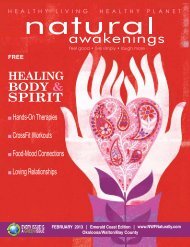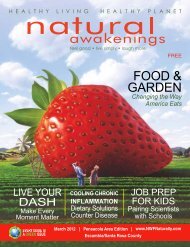Do You Have A Wheat Belly? - Natural Awakenings
Do You Have A Wheat Belly? - Natural Awakenings
Do You Have A Wheat Belly? - Natural Awakenings
Create successful ePaper yourself
Turn your PDF publications into a flip-book with our unique Google optimized e-Paper software.
for snacks, two slices of whole wheat bread for lunch and<br />
whole wheat pasta for dinner results in too much exposure<br />
to amylopectin A, and repeated spikes in blood sugar levels.<br />
This leads to insulin resistance and cultivates the growth of<br />
visceral fat in the abdomen, which tends toward diabetes and<br />
other inflammatory responses.<br />
Even worse, the gliadin protein in wheat is an opiate<br />
that stimulates appetite and addictive eating behavior (it does<br />
not relieve pain). All this plus the direct intestinal toxic effects<br />
of the wheat germ agglutinin protein in wheat add up to<br />
a destructive ingredient that spurs acid reflux, bowel urgency<br />
and irritable bowel syndrome, and leads to inflammation in<br />
various organs.<br />
Becoming Gluten-free<br />
<strong>Natural</strong>ly<br />
by Jude Forsyth<br />
Dawn DaLili, a naturopathic doctor and owner of<br />
Bluewater <strong>Natural</strong> Health, in Niceville, has seen<br />
the adoption of a gluten-free diet improve the lives of<br />
many people, beginning with her own in her early 20s.<br />
“Throughout my life, I seen that a healthy diet is fundamental<br />
to health and well-being,” she says.<br />
DaLili notes that a healthy diet is based upon what<br />
you eat, not what you avoid, and so going gluten-free<br />
is not enough if that simply involves replacing glutencontaining<br />
foods with commercially produced glutenfree<br />
items, which tend to be overly refined and high in<br />
sugar content. “The better approach is to focus on what<br />
is health-promoting; this means including a variety of<br />
colorful, preferably organic, foods in their natural (unrefined)<br />
state,” explains Dalili.<br />
Dr. Jim Bledsoe is a holistic practitioner with a<br />
Ph.D. in nutritional science. As the owner of Mind,<br />
Body and Spirit Holistic Counseling, he offers services<br />
on the second Saturday of the month at Healthquest, in<br />
Pensacola. He notes that diet is not the only source of<br />
gluten and suggests people check all ingredient labels<br />
carefully. “Some clients that have tried to eliminate gluten<br />
from their diets are still showing gluten intolerance<br />
symptoms, because gluten products have been added<br />
to some lotions and face makeup-type products.”<br />
For people with intestinal concerns, Bledsoe<br />
makes another suggestion. “If you do have any gluten<br />
intolerance symptoms, you should consider an enzyme<br />
product designed to help with the digestion of wheat<br />
or gluten products. I recommend that everyone take a<br />
good probiotic supplement.”<br />
Contact Dalili at 850-897-1177 or visit Bluewater<strong>Natural</strong>-<br />
Health.com. To make an appointment with Dr. Bledsoe,<br />
call 850-479-7220 or visit HealthQuestUSA.com.<br />
Describe how eliminating wheat has<br />
affected you.<br />
Thirty pounds ago, I was an enthusiastic consumer of<br />
“healthy whole grains,” who relied on pots of coffee or walking<br />
and other exercise to maintain focus and energy. My cholesterol<br />
values reflected my wheat-consuming habits: HDL<br />
27 mg/dl [milligrams per deciliter of good cholesterol] (very<br />
low), triglycerides 350 mg/dl (very high), and blood sugars in<br />
the diabetic range (161 mg/dl). I had high blood pressure of<br />
150/90 and excess weight around my middle.<br />
Eliminating wheat from my diet reversed all of these<br />
conditions without drugs, including the struggle to maintain<br />
attention and focus. Overall, I feel better today at 54 than I<br />
felt at 30.<br />
Are gluten-free foods the answer?<br />
Commercially produced gluten-free foods made with tapioca,<br />
cornstarch or rice starch—all poor replacements for wheat—are<br />
destructive to the body. Homemade or locally made gluten-free<br />
foods absent such ingredients are better, as are the free recipes<br />
available via <strong>Wheat</strong><strong>Belly</strong>Blog.com.<br />
Millet, quinoa and amaranth, whole grains that lack<br />
most of the undesirable properties of modern wheat, are<br />
better but not necessarily safe in unlimited quantities<br />
because most people today have spent their lives overexposed<br />
to carbohydrates. Eating only small portions of these<br />
non-wheat grains is key.<br />
For more information visit <strong>Wheat</strong><strong>Belly</strong>Blog.com.<br />
“Building<br />
Strong,<br />
Healthy<br />
Families”<br />
CHILDREN<br />
TEENS<br />
ADULTS<br />
EXPERIENCE<br />
NATURAL HEALING!<br />
Acupuncture and<br />
Non-Needle Procedures<br />
Pharmaceutical Grade Herbs<br />
Also Formulated For Children<br />
Acupressure & Reflexology<br />
That Patients Can <strong>Do</strong> At home<br />
KATHERINE SEMMES, MTOM<br />
ACUPUNCTURE PHYSICIAN<br />
TREATING:<br />
• Respiratory Issues<br />
Chronic Colds & Ear<br />
Infections, Asthma, Allergies<br />
• Digestive Disorders<br />
• Stress-related Ailments<br />
EASTERN TRADITIONS<br />
850-554-3464 7552 Navarre Pkwy<br />
In Harvest Village Suite 6 • Navarre<br />
natural awakenings September 2012<br />
23








